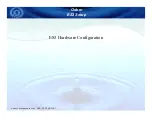
29 |
Vanguard
®
ID Total Knee
Surgical Technique
Figure 38
Femoral Component Implantation
While mixing another 40g unit of cement, pulse lavage
and dry the femoral side again.
As soon as the cement properties permit, apply a layer
over the entire bone-opposing surface of the appropriate
femoral component.
Avoid contamination of the implant-cement interface.
Note:
The cement should overfill the pockets on distal
and chamfer facets by 3–4 mm and on the anterior
and posterior facets by 1–2 mm.
Apply cement to the prepared femur and pressurize the
cement, striving for penetration of 3–5 mm, with special
attention given to pressurizing cement into the anterior
facet, as seating of the implant will not contribute much
to cement penetration in this area (Figure 38).
Any cement remaining proud on the posterior facet
should be scraped flush to the bone before proceeding,
so that it is not displaced and inaccessible upon seating
of the femoral component:
– Use of a cement gun/cartridge equipped with a
pressurizing nozzle is recommended to deliver
and pressurize cement into the prepared holes
and across the femoral facets.
– Cement may also be applied and pressurized
manually.






































